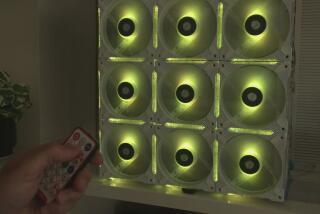A Market Is Born of Anthrax Threat
When anthrax spores turned up in the mail in October, government officials and millions of anxious Americans saw it as a dangerous threat.
A handful of companies saw it as an irresistible business opportunity.
Entrepreneurial firms have suggested X-rays, microwaves, ultraviolet light, lasers, electromagnetic pulses and even plain old heat as ways to kill anthrax. Tainted mail has sparked a flurry of invention to adapt technologies developed for civilian uses such as drying auto paint and killing E. coli to serve the emerging multibillion-dollar market for fighting bioterrorism.
“We’ve been getting solicitations from all over the place,” U.S. Postal Service spokesman Gerry Kreienkamp said. “Anyone who thinks they have something to offer, they’ve been offering it.”
The Postal Service already has awarded two contracts worth $40 million for equipment to sanitize mail by irradiating it with electron beams. Several other companies across the country are developing similar machines for use in busy corporate mailrooms.
The urgency to develop new technology is great because mail is particularly vulnerable to attack. In many respects, it is the ideal vector for a terrorist seeking to inflict widespread damage while remaining anonymous. Mail is delivered six days a week to 100 million households and millions of businesses.
In addition, corporations are looking for ways to sterilize the letters and packages they process in mailrooms before they are delivered to employees.
These are the perfect ingredients for an instantly huge new market--and it is beckoning.
Soon after anthrax-tainted letters arrived at NBC Nightly News offices in New York and in mailrooms on Capitol Hill, employees at Consolidated Machine Corp. in Boston joked about cleansing mail with their company’s steam sterilizers, normally used for glassware, hospital garments and stainless steel medical instruments.
Then they gave it a try.
“We threw some mail into our own sterilizer to see what would happen to it, and nothing happened,” said Arthur Trapotsis, head of research and development at the 55-year-old company. “We were a little surprised. I thought maybe the seals might open, but that didn’t happen.”
After that successful trial run, Consolidated Machine sold its first mail-cleansing unit to a New York customer that uses it to sterilize a few thousand letters each day. The company plans to market additional units in various sizes at prices ranging from $20,000 to $100,000, Trapotsis said.
The current wave of technological innovation to meet a pressing social need is in marked contrast to the sort of entrepreneurship that fueled the dot-com revolution. In that case, new companies bankrolled by generous venture capitalists sprang up in rapid succession, but they often struggled to find customers who needed their services.
“The dot-coms were all based on the Internet, which was a new technology,” said Eric von Hippel, a professor who studies the economics of innovation at MIT’s Sloan School of Management. “But often they weren’t in new markets. This is a new market.”
Despite the burst of creative thinking, some health experts caution against relying too heavily on new technology. For instance, machines that work well in laboratory tests might may not be as reliable in constant everyday use.
“Many of these things have not been well researched, they have not been well documented, and they have not proved to be really practical in a routine-use environment,” said David Bruckner, chief of the laboratory medicine division at the UCLA School of Medicine. “I would be very concerned about marketing this type of thing to the general public in a way that would make them come away feeling that this was totally safe and effective. It may or may not be.”
But companies in a variety of industries are pressing ahead. “The solution occurred to me almost immediately,” said Gene Ray, chief executive of Titan Corp., a $1.5-billion firm with two contracts from the U.S. Postal Service to irradiate mail with electron beams. “I got e-mails from at least 10 different employees. Once you knew anthrax was a bacteria, we knew this was a solution.”
Titan developed its technology about a decade ago while working to develop a way to intercept intercontinental ballistic missiles using linear accelerators as part of the original “Star Wars” missile defense program.
The system was never built, so the San Diego company tried to find other uses for the technology. It eventually was adapted to sterilize medical equipment and to irradiate food to kill harmful bacteria such as E. coli.
Titan uses a standard linear accelerator to generate an electron beam with magnets to force the beam to sweep up and down. As letters and packages pass in front of the beam, it breaks the double helix inside any hidden anthrax spores. That prevents the bacteria from replicating, rendering it useless.
Other companies take different approaches.
Dick Garard’s Lambda Technologies Inc. in Morrisville, N.C., is commercializing variable microwave frequency technology to cure polymer adhesives on semiconductor chips and circuits. About 60 of its ovens have been installed around the world.
Garard has investigated whether microwave technology could be used to pasteurize blood-substitute products by tuning the frequency to wavelengths that heat--and kill--undesirable molecules but preserve others. When he learned of the emerging anthrax threat, he suspected he was looking at a significant business opportunity.
Standard microwaves could ignite letters and packages containing metal, such as staples and paper clips. But Lambda’s technology doesn’t rely on a single frequency, so it doesn’t create the standing waves and energy differentials that cause arcing and start fires, Garard said.
Initial tests conducted by scientists at the University of North Carolina in Chapel Hill were promising, but Garard would like to see the results verified by the Army or the national Centers for Disease Control and Prevention before bringing any products to market. If all goes well, each unit could add at least $300,000 to Lambda’s coffers and account for half the company’s sales, he said.
Lou Panico said he was drawn to this market by a sense of patriotism. His company, Xenon Corp., uses ultraviolet light to sterilize hospital equipment and to cure items ranging from DVDs to fiber optics to the coating on cars.
“Before Sept. 11, we were focusing on sterilizing hospital keyboards to kill communicable diseases,” said Panico, chief executive of the Woburn, Mass.-based company. “Then we diverted to mail. I’m an ex-Marine, so I got very patriotic. I wanted to help.”
The result is the SteriPulse XL 5000, which can cleanse 5,000 pieces of mail in a 24-hour period. It comes with a $250,000 price tag, and Panico expects it to be so popular with small post offices and corporate customers that it could account for 50% of the company’s sales, which were $3.7 million last year.
That might be wishful thinking for a product that can disable anthrax spores only on the surface of letters and packages, but not kill those that might lurk inside. The Postal Service has panned UV technology for that reason.
Precision Environmental Inc. sold one of its $9,500 heat chambers to Gannett Co., the media company that publishes USA Today. For 17 years, Redwood City, Calif.-based Precision Environmental has been using heat instead of toxic chemicals to kill viruses, molds and insects inside buildings.
Soon after the anthrax attacks, a biologist who worked with the company called CEODave Hedman and suggested he develop a system for sterilizing mail.
The result is a heat cabinet about the size of a large refrigerator that can bake mail at 300 degrees Fahrenheit for eight hours--more than long enough to kill anthrax spores inside envelopes. The only thing that distinguishes treated mail from untreated mail is that the plastic windows on some business envelopes curl up, Hedman said.
Kreienkamp, of the Postal Service, cautioned that a long-term solution might be far off. Sterilizing every piece of mail probably isn’t feasible, so postal executives are focusing on “anonymous mail,” the letters and packages that enter the system through corner collection boxes, mail slots and the like.
Ultimately, Kreienkamp said, the Postal Service would like to combine anthrax-busting technology with a particle-detection system that can tell whether dangerous spores are in the mail before they are zapped.
*
Anthrax Zappers
(tabular data not included)
More to Read
Inside the business of entertainment
The Wide Shot brings you news, analysis and insights on everything from streaming wars to production — and what it all means for the future.
You may occasionally receive promotional content from the Los Angeles Times.











